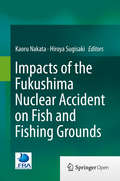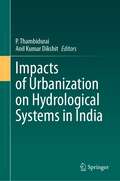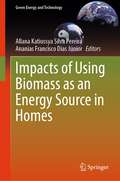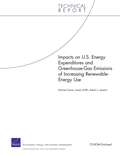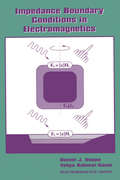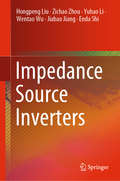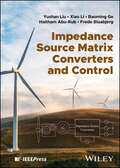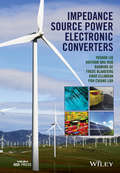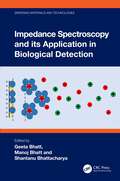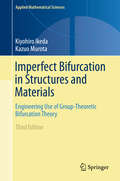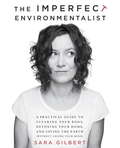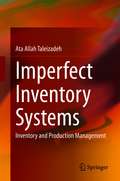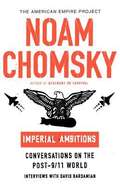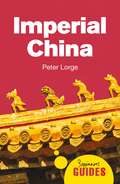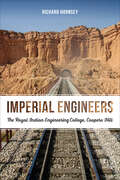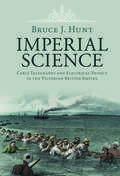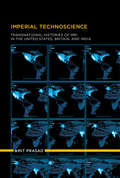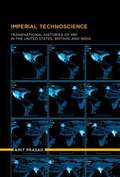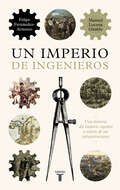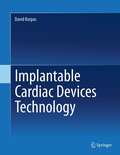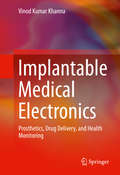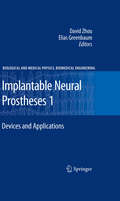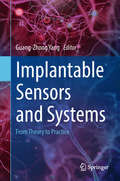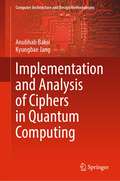- Table View
- List View
Impacts of Selenium on the Biogeochemical Cycles of Mercury in Terrestrial Ecosystems in Mercury Mining Areas
by Hua ZhangFrom a new perspective, namely focusing on the interaction of selenium and mercury, this thesis provides new insights into traditional research on biogeochemical cycles of mercury in soil-plant interaction and associated human exposure and risks. The subject of this thesis is both valuable and timely, providing essential information not only on selenium-mercury interaction in the soil-plant system but also on how to assess the combined benefits and risk of co-exposure to mercury and selenium. This work also sheds light on future aspects regarding prevention, remediation and risk management for environmental mercury contamination. Presenting high-quality papers published in leading international SCI journals such as Environmental Health Perspectives and Environmental Science & Technology and having been recognized with the Special Award of Presidential Scholarship Award and Excellent Doctoral Dissertations Prize of the Chinese Academy of Sciences (CAS), this thesis offers a valuable resource for scientific communities, policy-makers and non-experts who are interested in this field. Dr. Hua Zhang works at the Norwegian Institute for Water Research (NIVA), Oslo, Norway.
Impacts of the Fukushima Nuclear Accident on Fish and Fishing Grounds
by Kaoru Nakata Hiroya SugisakiThis book presents the results from the Japanese Fisheries Research Agency's 3-year intensive monitoring of radionuclides in a variety of fish, plankton, benthos, and their living environments after the Fukushima Daiichi Nuclear Power Plant (FNPP) accident in March 2011. The book reveals the dynamics of contamination processes in marine and freshwater fish, mediated by the contamination of water, sediments, and food organisms; it also clarifies the mechanisms by which large variations in the level of contamination occurs among individual fish. Most importantly, the book includes a large amount of original measurement data collected in situ and for the first time assesses diffusion of radiocesium across the Pacific using both in situ data and a numerical simulation model. Also introduced are several new approaches to evaluate the impact of the release of radionuclides, including the measurement of radiation emission from an otolith section to identify the main period of contamination in fish. The FNPP accident represents a rare instance where the environmental radioactivity level was elevated steeply through atmospheric fallout and direct discharge of radioactive water into the sea over a short period of time. Replete with precise scientific data, this book will serve as an important resource for research in fields such as fishery science, oceanography, ecology, and environmentology, and also as a solid basis for protecting fisheries from damage resulting from harmful rumors among the general public.
Impacts of Urbanization on Hydrological Systems in India
by P. Thambidurai Anil Kumar DikshitThis book documents the various impacts of urbanization on hydrological systems and water resources. The first half of the book is focused on urbanization and surface waters, starting with the status of hydrological systems in the urban areas, i.e. the catchment characteristics and changes in rainfall dynamics. The most pronounced hydrological problems in cities are changes in runoff due to precipitation. Recently, rain events have been less frequent but more intense, sometimes leading to flash floods. Though the substantial increase in runoff causes floods in the urbanized area, it may be attributed to the reduction of infiltration due to construction of roads. This, in turn, results in groundwater decline and depletion. The second half of the book covers the impact of urbanization on groundwater, which starts with hindered or significantly reduced recharge taking place due to altered urban surfaces. The limited groundwater resources are over-exploited by the urban population, leading to water scarcity and depletion. Groundwater gets polluted due to solid waste dumping sites or by wastewaters discharged by industries. The book will be useful for researchers, educators, municipal/city authorities, government officials, and NGOs.
Impacts of Using Biomass as an Energy Source in Homes (Green Energy and Technology)
by Allana Katiussya Silva Pereira Ananias Francisco Dias JúniorThe book deepens understanding of biomass sources and technologies used for cooking worldwide. It contributes directly to the creation of policies aimed at the mitigation of climate change.Historically, wood is considered humanity's first source of energy. Even after decades of use and industrialization processes, it is still considered the most important single source of renewable energy. About a third of the world's population is energetically dependent on wood for cooking and/or heating. Recently, the Covid-19 pandemic made it impossible to purchase fuels such as liquefied petroleum gas (LPG), forcing families in financial difficulties to opt for cheaper and more accessible sources of energy, such as wood and vegetable coal. This has been the picture of many families around the world and negatively impacts the environment and energy security. Considering that there are still many wood residues that are wasted and that tropical forests need to be conserved, knowledge about the energy use of wood residues is also essential. This is even more relevant when considering the significant volume of biomass coming from the sustainable management of the largest tropical forest in the world, the Amazon Forest.The book considers which wood variables should be taken into account when thinking about energy generation, how do food cooking technologies contribute to potentiating pollutants emissions, and how can these harmful effects be mitigated. It describes the chemical composition of biomass and the chemical compounds released during its burning, as well as their impacts on the environment and human health. It also presents the influence that technologies used in food cooking have on pollutant emissions and which alternatives can be used, such as the use of solar energy.
Impacts on U.S. Energy Expenditures and Greenhouse-Gas Emissions of Increasing Renewable-Energy Use
by Michael Toman Robert J. Lempert James GriffinHow could producing 25 percent of U.S. electricity and motor-vehicle transportation fuels from renewables by the year 2025 affect U.S. consumer energy expenditures and CO2 emissions? This report finds that reaching 25 percent renewables with limited impact on expenditures requires significant progress in renewable-energy technologies and biomass production. Without substantial innovation in these areas, expenditures could increase considerably.
Impedance Boundary Conditions In Electromagnetics
by Daniel J. HoppeElectromagnetic scattering from complex objects has been an area of in-depth research for many years. A variety of solution methodologies have been developed and utilised for the solution of ever increasingly complex problems. Among these methodologies, the subject of impedance boundary conditions has interested the authors for some time. In short, impedance boundary conditions allow one to replace a complex structure with an appropriate impedance relationship between the electric and magnetic fields on the surface of the object. This simplifies the solution of the problem considerably, allowing one to ignore the complexity of the internal structure beneath the surface. This book examines impedance boundary conditions in electromagnetics. The introductory chapter provides a presentation of the role of the impedance boundary conditions in solving practical electromagnetic problems and some historical background. One of the main objectives of this book is to present a unified and thorough discussion of this important subject. A method based on a spectral domain approach is presented to derive the Higher Order Impedance Boundary Conditions (HOIBC). The method includes all of the existing approximate boundary conditions, such as the Standard Impedence Boundary Condition, the Tensor Impedence Boundary Condition and the Generalised Impedance Boundary Conditions, as special cases. The special domain approach is applicable to complex coatings and surface treatments as well as simple dielectric coatings. The spectral domain approach is employed to determine the appropriate boundary conditions for planar dielectric coatings, chiral coatings and corregated conductors. The accuracy of the proposal boundary conditions is discussed. The approach is then extended to include the effects of curvature and is applied to curved dielectric and chiral coatings. Numerical data is presented to critically assess the accuracy of the results obtained using various forms of the impedence boundary conditions. A number of appendices that provide more detail on some of the topics addressed in the main body of the book and a selective list of references directly related to the topics addressed in this book are also included.
Impedance Source Inverters
by Hongpeng Liu Zichao Zhou Yuhao Li Wentao Wu Jiabao Jiang Enda ShiThis book focuses on impedance source inverters, discussing their classification, advantages, topologies, analysis methods, working mechanisms, improvements, reliability, and applications. It summarizes methods for suppressing DC-link voltage spikes and duty loss, which can pose a problem for researchers; and presents novel, efficient, steady state and transient analysis methods that are of significant practical value, along with specific calculation examples. Further, the book addresses the reliability of impedance source inverters, adopting a methodology from reliability engineering to do so. Given its scope, it offers a valuable resource for researchers, engineers, and graduate students in fields involving impedance source inverters and new energy sources.
Impedance Source Matrix Converters and Control
by Yushan Liu Xiao Li Baoming Ge Haitham Abu-Rub Frede BlaabjergTechnical resource presenting the latest power conversion solutions to advance the role of AC-AC power electronics in various applications. Compiling state-of-the-art research from around the world, Impedance Source Matrix Converters and Control provides a rich diversity of scientific work experience and scholarly approaches on the fundamentals and advances of power electronic converters for motor drives, renewable energies, and industry applications. The reader will be able to apply the learnt design approaches in this book for building and researching the future generation of efficient power electronic converters: more efficient, more reliable, less expensive, lighter, and less voluminous. The text introduces impedance source matrix converters in four distinct parts, covering the basics, converter topology, control, and applications. Its main focus is on the detailed understanding of advanced concepts related to fundamentals of impedance source matrix converters, and provides associated models, analysis, modulation, and final design and optimization control. Additional tables, questions/answers, tutorials, PowerPoint presentations, and selected simulation and experimental results are discussed in order to impart seamless reader comprehension. Written by four highly qualified academics with significant experience in the field, Impedance Source Matrix Converters and Control covers sample topics such as: Operating principles and modulation methods for impedance source direct/indirect matrix converters and 3-1-phase matrix converters Optimum operation control of LC filter integrated impedance source indirect matrix converters and comparison and control strategies of typical impedance source matrix converters Design and improvement in the electricity supply’s reliability, efficiency, compact volume, power quality, and sustainability Challenges and key technologies within the field of impedance source matrix converters, and solutions and directions for further research and applicationsImpedance Source Matrix Converters and Control is an essential resource on the latest developments in the field for researchers, postgraduate students, and graduate students studying power electronics and renewable energy conversion. The text is also a useful reference for R&D engineers involved with the development of power converters/inverters.
Impedance Source Power Electronic Converters
by Haitham Abu-Rub Omar Ellabban Yushan Liu Baoming Ge Frede Blaabjerg Poh Chiang LohImpedance Source Power Electronic Converters brings together state of the art knowledge and cutting edge techniques in various stages of research related to the ever more popular impedance source converters/inverters. Significant research efforts are underway to develop commercially viable and technically feasible, efficient and reliable power converters for renewable energy, electric transportation and for various industrial applications. This book provides a detailed understanding of the concepts, designs, controls, and application demonstrations of the impedance source converters/inverters. Key features: Comprehensive analysis of the impedance source converter/inverter topologies, including typical topologies and derived topologies. Fully explains the design and control techniques of impedance source converters/inverters, including hardware design and control parameter design for corresponding control methods. Presents the latest power conversion solutions that aim to advance the role of power electronics into industries and sustainable energy conversion systems. Compares impedance source converter/inverter applications in renewable energy power generation and electric vehicles as well as different industrial applications. Provides an overview of existing challenges, solutions and future trends. Supported by calculation examples, simulation models and results. Highly accessible, this is an invaluable resource for researchers, postgraduate/graduate students studying power electronics and its application in industry and renewable energy conversion as well as practising R&D engineers. Readers will be able to apply the presented material for the future design of the next generation of efficient power electronic converters/inverters.
Impedance Spectroscopy and its Application in Biological Detection (Emerging Materials and Technologies)
by Geeta Bhatt Manoj Bhatt Shantanu BhattacharyaThis book includes basics of impedance spectroscopy technology, substrate compatibility issues, integration capabilities, and several applications in the detection of different analytes. It helps explore the importance of this technique in biological detection, related micro/nanofabricated platforms and respective integration, biological synthesis schemes to carry out the detection, associated challenges, and related future directions. The various qualitative/quantitative findings of several modules are summarized in the form of the detailed descriptions, schematics, and tables. Features: Serves as a single source for exploring underlying fundamental principles and the various biological applications through impedance spectroscopy Includes chapters based on nonbiological applications of impedance spectroscopy and IoT-enabled impedance spectroscopy-based methods for detection Discusses derivations, substrates, applications, and several integrations Describes micro/nanofabrication of impedance-based biological sensors Reviews updated integrations like digital manufacturing and IoT This book is aimed at researchers and graduate students in material science, impedance spectroscopy, and biosensing.
Imperfect Bifurcation in Structures and Materials: Engineering Use of Group-Theoretic Bifurcation Theory (Applied Mathematical Sciences #149)
by Kiyohiro Ikeda Kazuo MurotaMost physical systems lose or gain stability through bifurcation behavior. This book explains a series of experimentally found bifurcation phenomena by means of the methods of static bifurcation theory.
The Imperfect Environmentalist
by Sara GilbertActress, producer, mother, and imperfect environmentalist, Sara Gilbert understands how helping the environment can seem overwhelming. Between keeping up with work, friends, and kids, who has the time or money to maintain a compost pile, become an activist, or knit a sweater out of recycled grocery bags? Fortunately, we now know that small changes here and there in our everyday lives can make a big impact on the environment. We just need to know where to begin. That's where Gilbert comes in, with this tongue-in-cheek reference guide packed full of helpful information, available at your fingertips. Read it cover to cover or just open it up to a random page; you can take what you want from it when you want. Whether you've got money to burn or have to crash on a friend's couch, here are all of the eco-essentials to get the planet back on track, and you won't have to hug a single tree--unless tree-hugging is your thing. Sharing the basics on health and beauty, work and money, home and gardening, family and fitness, and more, The Imperfect Environmentalist cuts through the clutter--both in our homes and in our heads--and offers simple approaches to help us clear out the pollutants, put down the poisons, and begin to breathe easy again--one 100% recycled page at a time.Advance praise for The Imperfect Environmentalist "This book really opened my eyes. Then my eyes started stinging and tearing from all the toxins in the environment I'm now aware of. Thanks, Sara, I have a lot to do now."--Lisa Kudrow "Sara's passion and commitment to the environment have given me an awareness that I never had before about our planet. I learn from Sara every day and she makes me want to be a better person. See, you can teach an old dog new tricks."--Sharon OsbourneFrom the Trade Paperback edition.
Imperfect Inventory Systems: Inventory and Production Management
by Ata Allah TaleizadehThis book examines inventory and production strategies that can reduce unexpected breakdown costs. It highlights different EPQ models to deal with such problems, providing optimal value derivations for decision variables. It provides proofs for concavity or convexity of objective functions. The chapters also include numerical examples for all the developed mathematical models. Imperfect Inventory Systems: Inventory and Production Management and Breakdown should be useful for professionals working on supply chains, but also researchers in operations research and inventory management.
Imperial Ambitions: Conversations on the Post-9/11 World
by Noam Chomsky David Barsamian[From the book cover] Timely, illuminating, and urgently needed, this volume of interviews conducted by award-winning radio journalist David Barsamian features Noam Chomsky discussing U.S. policies in the increasingly unstable post-9/11 world. In these exchanges, appearing for the first time in print, Chomsky offers his frank, provocative, and informed views on the invasion and occupation of Iraq, the doctrine of preemptive strikes against so-called rogue states, and the growing threat to international peace posed by the U.S. drive for domination. In his inimitable style, Chomsky also dissects the propaganda system that fabricates a mythic past and airbrushes inconvenient facts out of history.
Imperial China: A Beginner's Guide (Beginner's Guides)
by Dr. Peter LorgeIn 221 BCE, the Qin state conquered its neighbours and created the first unified Chinese empire in history. So began the imperial era, where dynasties claiming divine assent ruled for more than 2,000 years. Borders shifted and emperors struggled to exert control over every region of their diverse territories. Elites held that they were inheritors of a rich, pre-imperial culture, while their society produced world-changing inventions such as the compass, printing, gunpowder and the gun. And imperial China itself was altered as it came into contact with others through trade, exploration and war. For anyone curious about this fascinating period, Peter Lorge introduces imperial China&’s major ruling dynasties, religions, arts, thinkers, inventions, military advancements, economic developments and historians.
Imperial Engineers: The Royal Indian Engineering College, Coopers Hill
by Richard HornseyEstablished in 1871 on the outskirts of London, the Royal Indian Engineering College at Coopers Hill was arguably the first engineering school in Britain. For thirty-five years the college helped staff the government institutions of British India responsible for the railways, irrigation systems, telegraph network, and forests. Founded to meet the high demand for engineers in that country, it was closed thirty-five years later because its educational innovations had been surpassed by Britain’s universities – on both occasions against the wishes of the Government of India. Imperial Engineers offers a complete history of the Royal Indian Engineering College. Drawing on the diaries of graduates working in India, the college magazine, student and alumni periodicals, and other archival documents, Richard Hornsey details why the college was established and how the students’ education prepared them for their work. Illustrating the impact of the college and its graduates in India and beyond, Imperial Engineers illuminates the personal and professional experiences of British men in India as well as the transformation of engineering education at a time of social and technological change.
Imperial Science: Cable Telegraphy and Electrical Physics in the Victorian British Empire (Science in History)
by Bruce J. HuntIn the second half of the nineteenth century, British firms and engineers built, laid, and ran a vast global network of submarine telegraph cables. For the first time, cities around the world were put into almost instantaneous contact, with profound effects on commerce, international affairs, and the dissemination of news. Science, too, was strongly affected, as cable telegraphy exposed electrical researchers to important new phenomena while also providing a new and vastly larger market for their expertise. By examining the deep ties that linked the cable industry to work in electrical physics in the nineteenth century - culminating in James Clerk Maxwell's formulation of his theory of the electromagnetic field - Bruce J. Hunt sheds new light both on the history of the Victorian British Empire and on the relationship between science and technology.
Imperial Technoscience: Transnational Histories of MRI in the United States, Britain, and India (Inside Technology)
by Amit PrasadA study of science and technology practices that shows how even emergent aspects of research and development remain entangled with established hierarchies.In the last four decades, during which magnetic resonance imaging (MRI) has emerged as a cutting-edge medical technology and a cultural icon, technoscientific imaginaries and practices have undergone a profound change across the globe. Shifting transnational geography of tecchnoscientific innovations is making commonly deployed Euro/West-centric divides such as west versus non-west or “innovating north” versus “non-innovating south” increasingly untenable—the world is indeed becoming flatter. Nevertheless, such dualist divides, which are intimately tied to other dualist categories that have been used to describe scientific knowledge and practice, continue to undergird analyses and imaginaries of transnational technoscience. Imperial Technoscience puts into broad relief the ambivalent and contradictory folding of Euro/west-centrism with emergent features of technoscience. It argues, Euro/West-centric historicism, and resulting over-determinations, not only hide the vibrant, albeit hierarchical, transnational histories of technoscience, but also tell us little about shifting geography of technoscientific innovations. The book utilizes a deconstructive-empirical approach to explore “entangled” histories of MRI across disciplines (physics, chemistry, medicine, etc.), institutions (university, hospitals, industry, etc.), and nations (United States, Britain, and India). Entangled histories of MRI, it shows, better explain emergence and consolidation of particular technoscientific trajectories and shifts in transnational geography of science and technology (e.g. centers and peripheries).
Imperial Technoscience
by Amit PrasadThe origin of modern science is often located in Europe and the West. This Euro/West-centrism relegates emergent practices elsewhere to the periphery, undergirding analyses of contemporary transnational science and technology with traditional but now untenable hierarchical categories. In this book, Amit Prasad examines features of transnationality in science and technology through a study of MRI research and development in the United States, Britain, and India. In an analysis that is both theoretically nuanced and empirically robust, Prasad unravels the entangled genealogies of MRI research, practice, and culture in these three countries. Prasad follows sociotechnical trails in relation to five aspects of MRI research: invention, industrial development, market, history, and culture. He first examines the well-known dispute between American scientists Paul Lauterbur and Raymond Damadian over the invention of MRI, then describes the post-invention emergence of the technology, as the center of MRI research shifted from Britain to the U.S; the marketing of the MRI and the transformation of MRI research into a corporate-powered "Big Science"; and MRI research in India, beginning with work in India's nuclear magnetic resonance (NMR) laboratories in the 1940s. Finally, he explores the different dominant technocultures in each of the three countries, analyzing scientific cultures as shifting products of transnational histories rather than static products of national scientific identities and cultures. Prasad's analysis offers not only an innovative contribution to current debates within science and technology studies but also an original postcolonial perspective on the history of cutting-edge medical technology.
Un imperio de ingenieros
by Manuel Lucena Felipe Fernández-ArmestoUna nueva historia del Imperio español. Existe una figura ambigua, a medio camino entre lo militar y lo civil, que no se terminó de definir hasta hace poco: el ingeniero. Este libro es una exploración fascinante de su papel central en la forja del Imperio español. También es una celebración de la curiosidad humana, del ingenio y de la sorprendente capacidad de adaptación de unos profesionales que no se limitaron a trasladar los postulados europeos, sino que se empaparon de los nuevos espacios hallados en ultramar y los admiraron. La formación de un imperio requiere una reestructuración del paisaje con fines administrativos así como la vinculación de comunidades dispares en una sola entidad política por medio de infraestructuras. En el Imperio español, que se fijó en el romano como modelo, los ingenieros dirigieron obras públicas clave para lograr eficacia económica e integración social y cultural, pues facilitaban las comunicaciones y la salubridad y proporcionaban lo necesario para la defensa. Además, tuvieron que trabajar en un territorio extraordinariamente grande, con fronteras indefendibles y rutas vulnerables, o con recursos distribuidos de manera muy dispersa. Además, lo hicieron en un contexto de escasez financiera debida a las crisis económicas y las guerras dinásticas imperiales, dentro de un proceso de expansión tan agotador como asombroso. Felipe Fernández-Armesto y Manuel Lucena Giraldo exploran la actividad de los ingenieros a partir de un sinfín de atractivas historias, siempre bien contadas, y ofrecen una visión muy singular de la construcción del Imperio español, con sus virtudes y extraordinarios logros.
Implantable Cardiac Devices Technology
by David KorpasDevelopment in a majority of medicine branches today is based on technological advancement. This is the case in cardiology, where medical devices designed to correct heart rhythm - pacemakers, cardioverters-defibrillators and biventricular systems - are implanted in order to help a sick heart. Medical pacing devices today are only developed and produced globally by a several producers who make different technical solutions, algorithms, system parameters etc. The book Implantable Cardiac Devices Technology is targeted at biomedical, clinical engineers, technicians in practice, students of biomedical disciplines, and all medical staff who are required to understand the basics of pacing technology. The book is comprised of fourteen chapters that are further subdivided according to specific topics. Chapters dealing with basic heart anatomy, physiology and arythmology are included for the sake of comprehensiveness. Chapters avoid the description of special functions, but cover general procedures and parameters common for the systems of all producers. The book is intended to serve as a monothematic textbook. In order to make the text comprehensible and well arranged for a reader, references to professional literature are only provided once in a respective chapter.
Implantable Medical Electronics
by Vinod Kumar KhannaThis book is a comprehensive, interdisciplinary resource for the latest information on implantable medical devices, and is intended for graduate students studying electrical engineering, electronic instrumentation, and biomedical engineering. It is also appropriate for academic researchers, professional engineers, practicing doctors, and paramedical staff. Divided into two sections on Basic Concepts and Principles, and Applications, the first section provides an all-embracing perspective of the electronics background necessary for this work. The second section deals with pacing techniques used for the heart, brain, spinal cord, and the network of nerves that interlink the brain and spinal cord with the major organs, including ear and eye prostheses. The four main offshoots of implantable electronics, which this book discusses, are: The insertion of an implantable neural amplifier for accurate recording of neural signals for neuroengineering studies The use of implantable pulse generators for pacing the activities of diseased organs The use of implantable sensors for observing the influence of therapy and monitoring a patient's biological parameters The use of drug delivery systems to supervise the supply of accurate doses of medicine to affected parts Readers will also find chapters on the ess entials of clocking and timing circuits, pulse generator circuits, neural amplifiers, batteries, biomaterials and biocompatibility, and more. Unique to this book is also a chapter on cyber security and confidentiality concerns with implants. End-of-chapter questions and exercises help readers apply the content to practical use, making this an ideal book for anyone wishing to learn more about implantable devices.
Implantable Neural Prostheses 1
by David Zhou Elias GreenbaumThis book and its companion volume describe state-of-the-art advances in techniques associated with implantable neural prosthetic devices and their applications. Researchers, engineers, clinicians, students and any specialist in this field will gain a deeper understanding of the neural prosthetic techniques currently available for a wide range of biomedical applications. In part one of this two-volume sequence, Implantable Neural Prostheses 1: Devices and Applications, the focus is on implant designs and applications. Devices covered include sensory prosthetic devices such as cochlear implants, auditory midbrain implants, visual implants, spinal cord stimulators, and motor prosthetic devices including deep brain stimulators, Bions, and cardiac electro-stimulators. Readers will also understand the regulatory approval process in the U.S. and Europe for implantable medical devices.
Implantable Sensors and Systems
by Guang-Zhong YangImplantable sensing, whether used for transient or long-term monitoring of in vivo physiological, bio-electrical, bio-chemical and metabolic changes, is a rapidly advancing field of research and development. Underpinned by increasingly small, smart and energy efficient designs, they become an integral part of surgical prostheses or implants for both acute and chronic conditions, supporting optimised, context aware sensing, feedback, or stimulation with due consideration of system level impact.From sensor design, fabrication, on-node processing with application specific integrated circuits, to power optimisation, wireless data paths and security, this book provides a detailed explanation of both the theories and practical considerations of developing novel implantable sensors. Other topics covered by the book include sensor embodiment and flexible electronics, implantable optical sensors and power harvesting. Implantable Sensors and Systems – from Theory to Practice is an important reference for those working in the field of medical devices. The structure of the book is carefully prepared so that it can also be used as an introductory reference for those about to enter into this exciting research and developing field.
Implementation and Analysis of Ciphers in Quantum Computing (Computer Architecture and Design Methodologies)
by Anubhab Baksi Kyungbae JangThis book deals with the upcoming threat that may be posed by quantum computers on modern-day security standards, particularly those involving symmetric key ciphers. Considering the progress in the field of quantum computing over the past few years, there is an ever-growing need to analyze the ciphers that are being employed in ensuring security. The symmetric key ciphers are generally considered safe against quantum computers, though one must consider the possible impact due to Grover's search algorithm (that reduces the security claim to the square root bound of what is expected against a classical computer). This book consolidates all the major research works in one place and presents it with adequate clarity, making the subject matter easy to understand for seasoned researchers and students alike. It covers the prerequisite information, new research works (including some of the state of the art), thought-provoking problems for further research, and all the relevant source codes. This book is interesting to engineers, researchers, and students who work/study in the field of cryptography.

